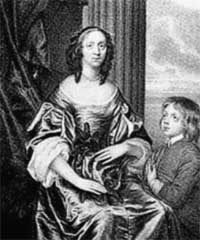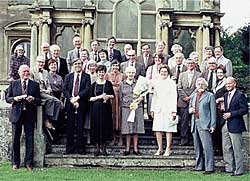Events during Spring 2020
Nora Witham lecture given by David Norbrook, 8 February 2020
‘Lucy Hutchinson’s Memoirs: The Manuscript as Autobiography’

Anyone who has ever tried to write about a friend or loved one will empathise with Lucy Hutchinson (1620-81), whose quatercentenary falls this year. A woman with a wide and discerning intellect, who wrote poetry, theology, and responses to Milton, she prized her marriage to John Hutchinson (1615-64) and the family which they raised at Owthorpe in Nottinghamshire. The outbreak of the British Civil Wars in the early 1640s thrust John Hutchinson to the centre of local events as the Governor of Nottingham Castle. He was one of the signatories of the warrant authorising the execution of Charles I in 1649 and was directly responsible for the slighting of Nottingham Castle (for fear of what Cromwell might do with it), two years later. At the Restoration of the Monarchy in 1660, Lucy forged a letter in her husband’s name (a tribute to her ability to master his signature), which offered an exculpation for his role in the death of Charles I and saved his life. John, never feeling comfortable at having escaped the fate of his fellow regicides, died in Sandown Castle in Kent, four years later, on charges of conspiracy.
Lucy, still only in her mid-forties, was left to mourn her husband’s life. As only a writer could, she mourned him by writing about him. It was a difficult and perplexing task. Like biographers before and since, she was faced with difficult choices: how far to fill-in the essential context and background to the life, and how far to concentrate on the individual life itself? What balance to achieve between public and private affairs? How to explain difficult, deeply-felt decisions such as the decision to support the execution of a king who saw himself as God’s chosen representative on earth? Fortunately for us, the nature of Lucy’s self-editing - her additions, deletions, blotting-out (and tearing-out) have left a suggestive set of archival traces in the book into which she wrote her ‘Life of John Hutchinson of Owthorpe in the County of Nottingham, Esquire’ - the proper and original title of the work, which was subsequently adapted, upon first publication in 1806, into ‘Memoirs of the Life...’.
The book is well-known to generations of both Nottinghamshire historians and historians of the British Civil Wars, for Lucy Hutchinson has much to say of value about both. However, in bringing out the particularities of the original manuscript, as part of a new critical edition of Lucy’s works, Professor David Norbrook and his colleagues (including Professor Martyn Bennett of the Thoroton Society) have returned to the minutiae of the text’s original production, including analysing the surface of the paper, the nature of the ink and the true significance of what, on initial sight, look like inky smudges, but when subjected to close inspection reveal a thumbprint which may well originate with Lucy herself.
David’s lecture explored the patient, scholarly process by which the editors recovered aspects of the text which have evaded (or just not interested) previous editors. If the survival of the original manuscript owes much to the intervention of Sydney Race, who encouraged Nottingham Castle Museum to purchase it in 1922 (the British Museum and Sidney Sussex College, Cambridge were potential competitors), then its long-term deposit at Nottinghamshire Archives has enabled it to survive the succeeding century intact. Appropriately enough, the work will be a central exhibit in the new ‘Rebellion Gallery’ at Nottingham Castle, when it reopens in the spring of 2021, a century after the book returned to its native county.
In questions, John Beckett raised the issue - hinted at by David in his lecture - of a connection with the county’s great antiquarian historian, and the Society’s eponymous hero, Dr Robert Thoroton. John wondered if they could have met given that Owthorpe and Car Colston (Thoroton’s home) were only about eight miles apart as the crow flies. The society’s President, Adrian Henstock, who was unfortunately unable to attend the lecture, subsequently expressed his doubts that they ever met, despite their being very close contemporaries in age. As far as Adrian is aware, Lucy lived in London before moving to her husband’s home in 1641, which is when Thoroton was studying at Cambridge; he received his MA there in 1643 at the age of 22. His movements for the rest of the Civil War and the Commonwealth are unknown, but as a non-combatant Royalist it seems possible that he lay low with his parents at Car Colston and perhaps moved into Newark along with many Royalist gentry towards the end of the war. Lucy of course moved into Nottingham Castle with her husband before returning to Owthorpe in 1647. It is of course possible that, as near neighbours in the Vale of Belvoir, they may have come into contact, but, if so, Adrian suspects there would have been enmity on both sides. Lucy would no doubt have thought of him as a mere physician!
Although Thoroton escaped sequestration of his property after the war, his active Royalist father-in-law Gilbert Boun did not, and Robert spent much time and money sorting out his debts. His bitter comments reveal his attitude towards the Hutchinson family: ‘After he [Gilbert] had been imprisoned at Derby about a year or more by the first setters-up of the late horrid Rebellion in those parts he was - with the loss of all he had - violently expelled by the Governor of Nottingham’ from his Nottingham town house. Thoroton’s entry for Owthorpe in the Antiquities of Nottinghamshire provides a pedigree of the Hutchinson family including both John and Lucy but his only comment is to say that the old church was rebuilt by Colonel John Hutchinson who was buried there. There is a memorial to him with text penned by Lucy. David revealed that Lucy wrote eight alternative versions of this epitaph in manuscript before settling on the one we see today.
These insights demonstrate why Lucy felt compelled to write the life of her husband and why it may well have been the hardest literary accomplishment of her life; she was writing for the benefit of her children as much as (if not more than) a critical posterity. Why the manuscript lay unpublished until 1806 is another story.
Richard A Gaunt
Thoroton Lecture 14 March 2020
A report from John Beckett.
 Thoroton members celebrate the retirement of Keith Train in 1984, at Flintham Hall. Taken from the Neville Hoskins Collection.
Thoroton members celebrate the retirement of Keith Train in 1984, at Flintham Hall. Taken from the Neville Hoskins Collection.Many years ago, a speaker en route to address the Thoroton Society fell among thieves - literally, since they relieved him of his slides. Without the slides he could not give the talk. What were we to do?
I think we all went home. But Neville Hoskins went to his slide collection and provided the society with what was in effect a quiz for the day when another speaker was unable to speak. That day turned out to be 14 March 2020 when our appointed speaker, Dr Richard Dance, was unable to come to Nottingham as a result of the Coronavirus restrictions. Neville’s slides, now converted to Power Point, were presented by David Hoskins, and the relatively small but keen audience was asked to comment on the pictures.
Unsurprisingly some of the meeting was pure nostalgia, but many of the pictures tested our knowledge (or not) of some of the most obscure places in Nottingham. There were no marks out of 10, and no prize winner, but it was an interesting and informative afternoon, which challenged us all to think more clearly about how much we really do not know about our city. Some of the slides were of Thorotonians on excursions. Not only had we to guess the location of the picture, we had to adjust for the ageing process in the case of a few of our members! It was quite challenging really!